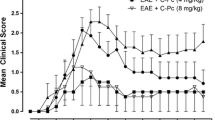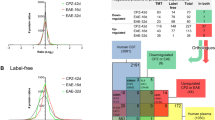Abstract
Multiple sclerosis is a neurological disorder that presents with symptoms including inflammation, neurodegeneration, and demyelination of the central nervous system (CNS). Secondary progressive multiple sclerosis (SPMS) manifests with serious physical disability. To quantitatively analyze differential protein expression in patients with SPMS, we performed two-dimensional fluorescence difference in-gel electrophoresis, followed by mass spectrometry on the cerebrospinal fluid of these patients and patients with other neurological diseases. Vitamin D-binding protein (DBP), gelsolin, albumin, etc. showed more than a 1.5-fold difference between the two groups. Based on these results, an experimental allergic encephalomyelitis (EAE) model of multiple sclerosis in Lewis rats was used to investigate DBP’s role in the disease. Protein levels, mRNA transcripts, and ligands of DBP in different regions of the CNS were evaluated under various vitamin D intake levels. Here, DBP levels increased in the experimental rat groups compared to the control groups regardless of vitamin D intake. Moreover, DBP mRNA levels varied in different parts of the CNS including spinal cords in the experimental groups. The observed differences between DBP protein and mRNA levels in the experimental groups’ spinal cords could be derived from the disruption of the blood–brain barrier. Furthermore, an interaction between DBP and actin was confirmed using coimmunoprecipitation and western blot. These results indicate a role for DBP in the actin scavenge system. Moreover, in the experimental group that received oral vitamin D3 supplement, we observed both delayed onset and diminished severity of the disease. When DBP was upregulated, however, the benefits from the vitamin D3 supplements were lost. Thus, we inferred that high levels of DBP were adverse to recovery. In conclusion, here we observed upregulated DBP in the cerebrospinal fluid could serve as a specific diagnostic biomarker for the progression of multiple sclerosis. Next, we demonstrate the vital function of increased levels of free vitamin D metabolites for multiple sclerosis treatment. Finally, vitamin D supplements may be particularly beneficial for SPMS patients.





Similar content being viewed by others
Abbreviations
- SPMS:
-
Secondary progressive multiple sclerosis
- EAE:
-
Experimental allergic encephalomyelitis
- 2-D DIGE:
-
Two-dimensional fluorescence difference in-gel electrophoresis
- DBP:
-
Vitamin D-binding protein
References
Rivers TM, Sprunt DH, Berry GP (1933) Observations on attempts to produce acute disseminate encephalomyelitis in monkeys. J Exp Med 58(1):39–53
Hafler DA (2004) Multiple sclerosis. J Clin Invest 113(6):788–794
Koch-Henriksen N, Sørensen PS (2010) The changing demographic pattern of multiple sclerosis epidemiology. Lancet Neurol 9(5):520–532
Miller D, Barkhof F, Montalban X, Thompson A, Filippi M (2005) Clinically isolated syndromes suggestive of multiple sclerosis, part I: natural history, pathogenesis, diagnosis, and prognosis. Lancet Neurol 4(5):281–288
Ottervald J, Franzén B, Nilsson K, Andersson LI, Khademi M, Eriksson B et al (2010) Multiple sclerosis: identification and clinical evaluation of novel csf biomarkers. J Proteomics 73(6):1117–1132
Leary SM, Porter B, Thompson AJ (2005) Multiple sclerosis: diagnosis and the management of acute relapses. Postgrad Med J 81(955):302–308
Confavreux C, Vukusic S, Moreau T, Adeleine P (2000) Relapses and progression of disability in multiple sclerosis. N Engl J Med 343(20):1430–1438
Viswanathan S, Unlü M, Minden JS (2006) Two-dimensional difference gel electrophoresis. Nat Protoc 1(3):1351–1358
Marouga R, David S, Hawkins E (2005) The development of the DIGE system: 2D fluorescence difference gel analysis technology. Anal Bioanal Chem 382(3):669–678
Disanto G, Ramagopalan SV, Para AE, Handunnetthi L (2011) The emerging role of vitamin d binding protein in multiple sclerosis. J Neurol 258(3):353–358
Schneider C, Schuetz G, Zollner TM (2009) Acute neuroinflammation in lewis rats—a model for acute multiple sclerosis relapses. J Neuroimmunol 213(1–2):84–90
Gomme PT, Bertolini J (2004) Therapeutic potential of vitamin D-binding protein. Trends Biotechnol 22(7):340–345
White P, Cooke N (2000) The multifunctional properties and characteristics of vitamin D-binding protein. Trends Endocrinol Metab 11(8):320–327
Jirikowski GF, Kaunzner UW, Dief Ael E, Caldwell JD (2009) Distribution of vitamin D binding protein expressing neurons in the rat hypothalamus. Histochem Cell Biol 131(3):365–370
Semra YK, Seidi OA, Sharief MK (2002) Heightened intrathecal release of axonal cytoskeletal proteins in multiple sclerosis is associated with progressive disease and clinical disability. J Neuroimmunol 122(1–2):132–139
Munger KL, Zhang SM, O’Reilly E, Hernán MA, Olek MJ, Willett WC et al (2004) Vitamin D intake and incidence of multiple sclerosis. Neurology 62(1):60–65
Nordvik I, Myhr KM, Nyland H, Bjerve KS (2000) Effect of dietary advice and n-3 supplementation in newly diagnosed MS patients. Acta Neurol Scand 102(3):143–149
McDonald WI, Compston A, Edan G, Goodkin D, Hartung HP, Lublin FD et al (2001) Recommended diagnostic criteria for multiple sclerosis: guidelines from the international panel on the diagnosis of multiple sclerosis. Ann Neurol 50(1):121–127
Liu S, Bai S, Qin Z, Yang Y, Cui Y, Qin Y (2009) Quantitative proteomic analysis of the cerebrospinal fluid of patients with multiple sclerosis. J Cell Mol Med 13(8A):1586–1603
Gressner OA, Lahme B, Gressner AM (2008) Gc-globulin (vitamin D binding protein) is synthesized and secreted by hepatocytes and internalized by hepatic stellate cells through ca(2+)-dependent interaction with the megalin/gp330 receptor. Clin Chim Acta 390(1–2):28–37
Spach KM, Hayes CE (2005) Vitamin D3 confers protection from autoimmune encephalomyelitis only in female mice. J Immunol 175(6):4119–4126
Li Y, Qin Z, Yang M, Qin Y, Lin C, Liu S (2011) Differential expression of complement proteins in cerebrospinal fluid from active multiple sclerosis patients. J Cell Biochem 112(7):1930–1937
Karp NA, Lilley KS (2005) Maximising sensitivity for detecting changes in protein expression: experimental design using minimal cydyes. Proteomics 5(12):3105–3115
Tewari AK, Popova-Butler A, El-Mahdy MA, Zweier JL (2011) Identification of differentially expressed proteins in blood plasma of control and cigarette smoke-exposed mice by 2-D DIGE/MS. Proteomics 11(10):2051–2062
Dujmovic I (2011) Cerebrospinal fluid and blood biomarkers of neuroaxonal damage in multiple sclerosis. Mult Scler Int 2011:767083
Kułakowska A, Ciccarelli NJ, Wen Q, Mroczko B, Drozdowski W, Szmitkowski M et al (2010) Hypogelsolinemia, a disorder of the extracellular actin scavenger system, in patients with multiple sclerosis. BMC Neurol 10:107
Chun RF (2012) New perspectives on the vitamin D binding protein. Cell Biochem Funct 30(6):445–456
McLeod JF, Cooke NE (1989) The vitamin D-binding protein, alpha-fetoprotein, albumin multigene family: detection of transcripts in multiple tissues. J Biol Chem 264(36):21760–21769
Paul C, Bolton C (1995) Inhibition of blood–brain barrier disruption in experimental allergic encephalomyelitis by short-term therapy with dexamethasone or cyclosporin A. Int J Immunopharmacol 17(6):497–503
Bennett J, Basivireddy J, Kollar A, Biron KE, Reickmann P, Jefferies WA et al (2010) Blood–brain barrier disruption and enhanced vascular permeability in the multiple sclerosis model eae. J Neuroimmunol 229(1–2):180–191
Haddad JG, Hu YZ, Kowalski MA, Laramore C, Ray K, Robzyk P et al (1992) Identification of the sterol- and actin-binding domains of plasma vitamin D binding protein (gc-globulin). Biochemistry 31(31):7174–7181
Lee WM, Galbraith RM (1992) The extracellular actin-scavenger system and actin toxicity. N Engl J Med 326(20):1335–1341
Haddad JG, Harper KD, Guoth M, Pietra GG, Sanger JW (1990) Angiopathic consequences of saturating the plasma scavenger system for actin. Proc Natl Acad Sci U S A 87(4):1381–1385
Piquette CA, Robinson-Hill R, Webster RO (1994) Human monocyte chemotaxis to complement-derived chemotaxins is enhanced by gc-globulin. J Leukoc Biol 55(3):349–354
Kew RR, Webster RO (1988) Gc-globulin (vitamin D-binding protein) enhances the neutrophil chemotactic activity of c5a and c5a des arg. J Clin Invest 82(1):364–369
Gressner O, Meier U, Hillebrandt S, Wasmuth HE, Köhl J, Sauerbruch T et al (2007) Gc-globulin concentrations and c5 haplotype-tagging polymorphisms contribute to variations in serum activity of complement factor c5. Clin Biochem 40(11):771–775
Shah AB, DiMartino SJ, Trujillo G, Kew RR (2006) Selective inhibition of the c5a chemotactic cofactor function of the vitamin D binding protein by 1,25(oh)2 vitamin d3. Mol Immunol 43(8):1109–1115
Head JF, Swamy N, Ray R (2002) Crystal structure of the complex between actin and human vitamin D-binding protein at 2.5 a resolution. Biochemistry 41(29):9015–9020
Munger KL, Levin LI, Hollis BW, Howard NS, Ascherio A (2006) Serum 25-hydroxyvitamin D levels and risk of multiple sclerosis. JAMA 296(23):2832–2838
Ascherio A, Munger KL, Simon KC (2010) Vitamin D and multiple sclerosis. Lancet Neurol 9(6):599–612
Nashold FE, Miller DJ, Hayes CE (2000) 1,25-Dihydroxyvitamin D3 treatment decreases macrophage accumulation in the CNS of mice with experimental autoimmune encephalomyelitis. J Neuroimmunol 103(2):171–179
Nashold FE, Hoag KA, Goverman J, Hayes CE (2001) Rag-1-dependent cells are necessary for 1,25-dihydroxyvitamin D(3) prevention of experimental autoimmune encephalomyelitis. J Neuroimmunol 119(1):16–29
Hayes CE, Nashold FE, Spach KM, Pedersen LB (2003) The immunological functions of the vitamin D endocrine system. Cell Mol Biol (Noisy-le-grand) 49(2):277–300
Carpenter TO, Zhang JH, Parra E, Ellis BK, Simpson C, Lee WM et al (2012) Vitamin D binding protein is a key determinant of 25-hydroxyvitamin D levels in infants and toddlers. J Bone Miner Res 28(1):213–221
Weinstein SJ, Stolzenberg-Solomon RZ, Kopp W, Rager H, Virtamo J, Albanes D (2012) Impact of circulating vitamin D binding protein levels on the association between 25-hydroxyvitamin D and pancreatic cancer risk: a nested case–control study. Cancer Res 72(5):1190–1198
Acknowledgments
We wish to thank the department of neurology of Shandong Provincial Hospital for supplying CSF samples. We also acknowledge the Laboratory of Systems Biology, Institute of Biomedical Sciences of Fudan University for providing MALDI-TOF/MS instruments.
Funding
This work was supported by the grants from Natural Science Foundation of China (to Shi-lian LIU; nos. 81070952 and 81271319).
Author information
Authors and Affiliations
Corresponding author
Additional information
Mingchong Yang and Zhaoyu Qin contributed equally to this work.
Electronic Supplementary Material
Below is the link to the electronic supplementary material.
ESM 1
DOC 1,726 kb
Rights and permissions
About this article
Cite this article
Yang, M., Qin, Z., Zhu, Y. et al. Vitamin D-binding Protein in Cerebrospinal Fluid is Associated with Multiple Sclerosis Progression. Mol Neurobiol 47, 946–956 (2013). https://doi.org/10.1007/s12035-012-8387-1
Received:
Accepted:
Published:
Issue Date:
DOI: https://doi.org/10.1007/s12035-012-8387-1




